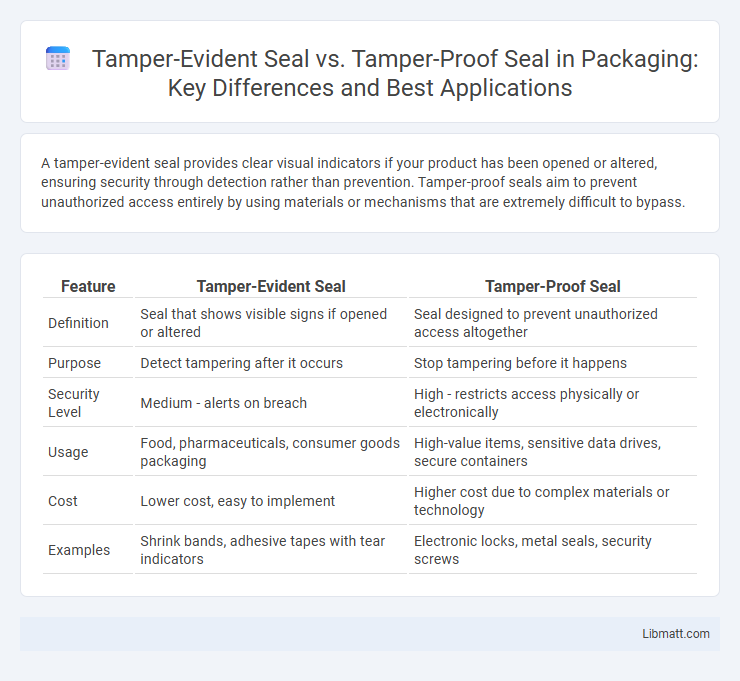A tamper-evident seal provides clear visual indicators if your product has been opened or altered, ensuring security through detection rather than prevention. Tamper-proof seals aim to prevent unauthorized access entirely by using materials or mechanisms that are extremely difficult to bypass.
Table of Comparison
| Feature | Tamper-Evident Seal | Tamper-Proof Seal |
|---|---|---|
| Definition | Seal that shows visible signs if opened or altered | Seal designed to prevent unauthorized access altogether |
| Purpose | Detect tampering after it occurs | Stop tampering before it happens |
| Security Level | Medium - alerts on breach | High - restricts access physically or electronically |
| Usage | Food, pharmaceuticals, consumer goods packaging | High-value items, sensitive data drives, secure containers |
| Cost | Lower cost, easy to implement | Higher cost due to complex materials or technology |
| Examples | Shrink bands, adhesive tapes with tear indicators | Electronic locks, metal seals, security screws |
Introduction to Security Seals
Tamper-evident seals provide visible indicators when unauthorized access or interference occurs, enhancing detection of security breaches. Tamper-proof seals are designed to prevent tampering entirely by using materials and locking mechanisms that resist unauthorized removal or manipulation. Both types play critical roles in securing products, packaging, and sensitive equipment, ensuring integrity and trust in supply chains and protection systems.
What is a Tamper-Evident Seal?
A tamper-evident seal is a security feature designed to indicate if a product has been opened or altered, providing visible signs of interference to ensure product integrity. It typically uses materials like adhesive labels or shrink bands that cannot be removed without leaving clear evidence of tampering. This type of seal is essential in industries such as pharmaceuticals, food packaging, and electronics to protect consumers and maintain trust.
What is a Tamper-Proof Seal?
A tamper-proof seal is a security feature designed to prevent unauthorized access or interference with a product or container by providing a physical barrier that is extremely difficult to bypass or alter without visible damage. Unlike tamper-evident seals, which show clear signs of tampering after interference, tamper-proof seals aim to block access altogether, ensuring maximum protection for sensitive items. These seals are commonly used in pharmaceuticals, electronics, and food packaging to safeguard your products from contamination or theft.
Core Differences: Tamper-Evident vs Tamper-Proof
Tamper-evident seals provide clear visual signs if a product has been opened or altered, ensuring that You can easily detect unauthorized access. Tamper-proof seals, on the other hand, are designed to prevent tampering altogether by making it extremely difficult or impossible to open without destruction. The core difference lies in tamper-evident seals signaling tampering after it occurs, whereas tamper-proof seals aim to block tampering from happening in the first place.
Security Levels: Which Offers Better Protection?
Tamper-evident seals provide a clear indication if a product has been accessed or altered, enhancing detection and deterrence against unauthorized interference. Tamper-proof seals, designed to be extremely difficult or impossible to remove without damage, offer higher protection by physically preventing tampering attempts. Your choice depends on the security level needed; tamper-proof seals offer superior protection, while tamper-evident seals focus on alerting you to potential breaches.
Applications of Tamper-Evident Seals
Tamper-evident seals are widely used in industries such as pharmaceuticals, food packaging, and electronics to provide visible proof of product integrity and unauthorized access. These seals are essential for maintaining product safety, ensuring regulatory compliance, and enhancing consumer trust by clearly indicating any tampering attempts. Common applications include medication bottles, food containers, and high-value electronic devices where evidence of interference must be unmistakably apparent.
Applications of Tamper-Proof Seals
Tamper-proof seals are extensively used in industries requiring high security, such as pharmaceuticals, electronics, and food packaging, to prevent unauthorized access and ensure product integrity. These seals provide a physical barrier that cannot be removed without obvious damage, making them ideal for safeguarding sensitive shipments and medical devices. Their application helps maintain compliance with regulatory standards by deterring tampering and counterfeiting.
Pros and Cons of Each Seal Type
Tamper-evident seals provide visible indication if a product has been opened, enhancing security and consumer trust, but they do not physically prevent tampering. Tamper-proof seals offer stronger protection by physically blocking access, reducing the risk of unauthorized entry, yet they may be more costly and inconvenient to remove. Choosing between tamper-evident and tamper-proof seals depends on balancing security needs, cost, and user convenience in applications such as pharmaceuticals, food packaging, and electronics.
Choosing the Right Seal for Your Needs
Selecting the right seal depends on whether you prioritize visible evidence of tampering or absolute prevention of access. Tamper-evident seals provide clear signs if a package has been opened, making them ideal for security and quality assurance in supply chains. Tamper-proof seals, designed to resist unauthorized removal without damage, are best for critical security situations where prevention is paramount.
Future Trends in Security Sealing Technology
Future trends in security sealing technology emphasize advanced tamper-evident seals featuring blockchain integration for real-time tracking and authentication. Innovations in tamper-proof seals incorporate smart materials and IoT sensors that detect and report unauthorized access instantly. These developments aim to enhance supply chain transparency and reduce counterfeiting across industries.
Tamper-evident seal vs tamper-proof seal Infographic

 libmatt.com
libmatt.com